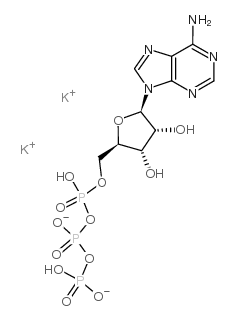ATP dipotassium
Modify Date: 2025-08-26 11:29:37

ATP dipotassium structure
|
Common Name | ATP dipotassium | ||
|---|---|---|---|---|
| CAS Number | 42373-41-1 | Molecular Weight | 583.36200 | |
| Density | N/A | Boiling Point | N/A | |
| Molecular Formula | C10H14K2N5O13P3 | Melting Point | N/A | |
| MSDS | N/A | Flash Point | N/A | |
Use of ATP dipotassiumATP dipotassium (Adenosine 5'-triphosphate dipotassium) is a central component of energy storage and metabolism in vivo, provides the metabolic energy to drive metabolic pumps and serves as a coenzyme in cells. ATP dipotassium is an important endogenous signaling molecule in immunity and inflammation[1][2]. |
| Name | adenosine 5'-triphosphate potassium salt |
|---|---|
| Synonym | More Synonyms |
| Description | ATP dipotassium (Adenosine 5'-triphosphate dipotassium) is a central component of energy storage and metabolism in vivo, provides the metabolic energy to drive metabolic pumps and serves as a coenzyme in cells. ATP dipotassium is an important endogenous signaling molecule in immunity and inflammation[1][2]. |
|---|---|
| Related Catalog | |
| In Vitro | ATP dipotassium (5mM; 1 hour) co-treatment with LPS (1 μg/ml) has a synergistic effect on the activation of the NLRP3 inflammasome in HGFs[3]. ATP dipotassium (2 mM; 0.5-24 hours) induces secretion of interleukin 1β, KC and MIP-2 from bone marrow derived macrophages (BMDMs) in vitro in a caspase-1 activation-dependent manner[4]. ATP dipotassium stimulats cytokine and chemokine secretion and inflammasome activation directly and indirectly induces in vitro neutrophil chemotaxis[4]. |
| In Vivo | ATP dipotassium (50 mg/kg; i.p.) protects mice against bacterial infection in vivo[4]. ATP dipotassium induces the secretion of IL1β, KC and MIP-2 and neutrophils recruitment in vivo[4]. Animal Model: Four-week-old Kunming mice (18-22 g)[4] Dosage: 50 mg/kg Administration: Intraperitoneal injection, before bacterial (E. coli) challenge Result: Protected mice from bacterial infection. |
| References |
[1]. Bonora M, et al. ATP synthesis and storage. Purinergic Signal. 2012 Sep;8(3):343-57. |
| Molecular Formula | C10H14K2N5O13P3 |
|---|---|
| Molecular Weight | 583.36200 |
| Exact Mass | 582.90800 |
| PSA | 314.22000 |
| Adenosintriphosphat,Tetrakaliumsalz |
| 5'-ATP-K2 |
| ADENOSINE-5'-TRIPHOSPHATE DIPOTASSIUM SALT |
| Adenosine 5'-(tetrahydrogen triphosphate),dipotassiuM salt |
| adenosine 5'-triphosphate dipotassium*from bacter |
| MFCD00084672 |
| ADENOSINE 5'-TRIPHOSPHATE DIPOTASSIUMFRO M BACTERIA |
| ATP POTASSIUM SALT |